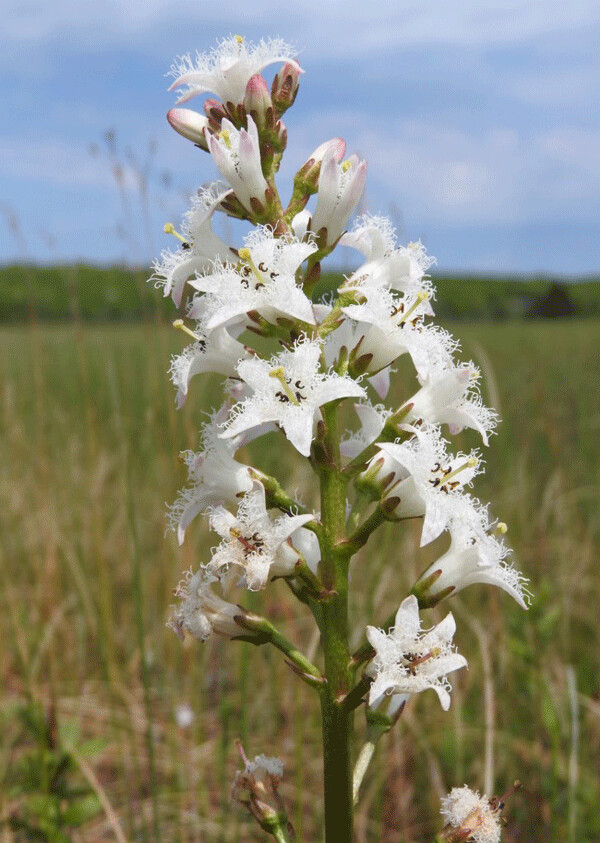News & Articles
Browse all content by date.

Adults wearing hip waders and wielding nets stepped gingerly into the wetland. An ecologist had just briefed them on the importance of aquatic macroinvertebrates for studying water quality, and now it was their job to catch some critters. The public boat landing at Bark Bay Slough State Natural Area near Herbster, WI, was a gorgeous setting for this adventure.
Bark Bay Slough is a freshwater estuary where the relatively warm, sediment-laden waters of the Bark River meet the clear, icy waters of Lake Superior. The lagoon is mostly separated from the lake by a sandy baymouth bar, making it a peaceful place to study water quality. Within this unique physical setting are equally delightful plants. Mats of floating vegetation and peat soils creep in from all sides of the lagoon and support both bog and fen communities.
The students in hip waders were participants in a Wisconsin Master Naturalist Volunteer training course. For an entire week they were assigned to explore beautiful places with natural resource professionals and learn a little bit about everything. Some folks take the course purely as personal edification, but most students are planning to apply their newfound knowledge to volunteer or professional naturalist experiences.
My job, besides coordinating logistics and piping in with cool facts, was to take photos. So as a couple of students waded across a knee-deep channel to sample insects west of the landing, I followed behind with my camera held high. After pushing through the cattails and finding stable footing, I looked up.
The mat of fen vegetation spread out before me like a magic carpet, floating on water instead of air. From this carpet rose a thick bouquet of flowers. Clusters of delicate, pink blossoms drooped from the graceful, arching stems of bog rosemary. Thread-like arcs of fen sedge filled in between. Rising above them were the frilly white flowers of bog buckbean. Its beauty was the crowning jewel.
Despite its slightly hokey and incorrect name, bog buckbean is one of the most magnificent members of a fen community. Bogs and fens are often confused, so that part of the name is no surprise. Bogs are peaty wetlands that receive all or most of their water from precipitation rather than from runoff, groundwater or streams. They are characterized by acidic soils with few nutrients. Fens are also peaty wetlands, but they receive input from groundwater, runoff, or other sources, which decreases their acidity and increases nutrients. The water of this peatland in the Bark Bay Slough meets and mixes with water from the estuary, which makes the bog buckbean’s habitat a fen.
The “buck” part of the flower’s name may be a corruption of the name Puck, who was a clever, mischievous elf in old English folklore. According to one account, the children of Devonshire, England, used to address Puck before traveling through the forest after dark, to ask for protection.
How the character and the plant came together is still a mystery to me, but this does bring up the fact that bog buckbean is found in wetlands around the globe! From North America to northern Asia, Europe, and Japan, this beautiful flower remains the same species. It’s a small world. Also unusual is that Menyanthes trifoliata is the only flower in its genus.
One alternative name of bog buckbean is bog hop, which refers to the English use of its bitter leaves to flavor beer. Those leaves are divided into three oval leaflets, and they must have reminded someone of the shape of broad beans from their garden because the “bean” in this plant’s name refers to their shape.
It’s the magnificent flowers, though, that really steal the show. The tall, cone-shaped inflorescence holds many feathery, white, star-like blossoms. The feathery petals aren’t a simple vanity. Pollination is carried out by bumblebees and other big bees. Small insects aren’t effective pollinators, so lacy fringes on the petals protect the flower’s valuable nectar from freeloaders.
The flowers make another investment in cross-pollination as well: some plants have a long pistil (female flower part) and short stamens (pollen-bearing flower parts), and some plants have the opposite combination. If a bee gets dusted with pollen from a long stamen, that pollen won’t rub off on another flower with a long stamen. Instead, the pollen will be at the perfect height to cross-pollinate a buckbean flower with a long pistil.
Looking back at my photos, all the buckbean flowers in this fen seem to have five, short, violet-colored stamens and a tall, yellow pistil in the center. Buckbean spreads more through rhizomes than seeds, so it’s quite possible that all of these flowers are part of the same wandering plant, connected by a network of horizontal stems.
After photographing the flowers and students, I bounced a few times on the floating mat of the fen, and wandered back to the group at the landing. Naturalists with nets had caught some neat little insects. After lunch, we paddled out to the baymouth bar and walked across to Lake Superior.
Geology, ecology, botany, biology, and people: all had come together for a special day at a special place.
Special Note: Emily’s book, Natural Connections: Exploring Northwoods Nature through Science and Your Senses is here! Order your copy at http://cablemuseum.org/natural-connections-book/. Listen to the podcast at www.cablemusum.org!
For 50 years, the Cable Natural History Museum has served to connect you to the Northwoods. Come visit us in Cable, WI! Our new exhibit: “Better Together--Celebrating a Natural Community” is now open!
| Tweet |


